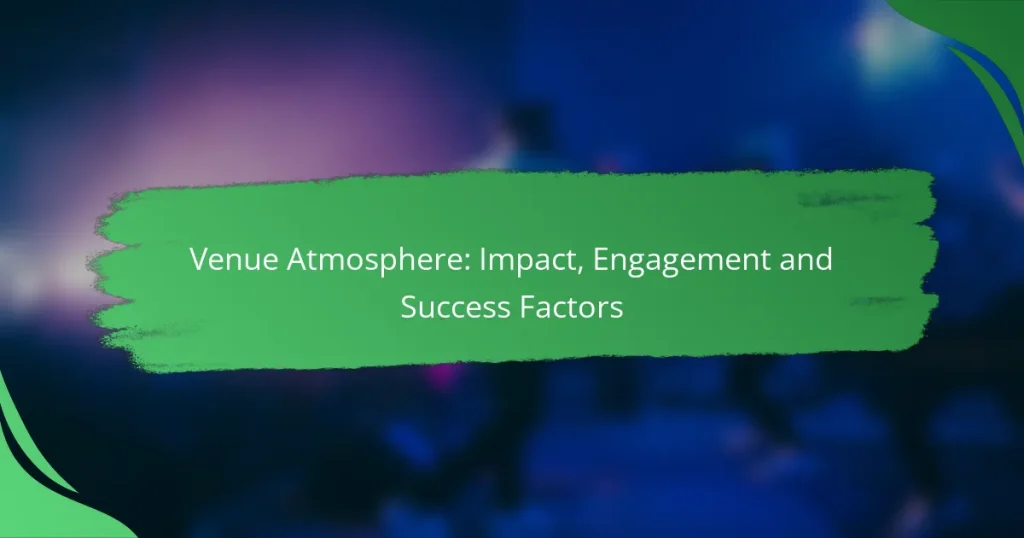The atmosphere of a venue plays a crucial role in determining the success of an event, as it directly impacts attendee experiences and perceptions. By focusing on elements such as lighting, sound quality, and layout, venues can create an engaging environment that fosters interaction and satisfaction, ultimately enhancing the effectiveness of the event.

How does venue atmosphere impact event success?
The atmosphere of a venue significantly influences the overall success of an event by shaping attendee experiences and perceptions. A well-designed environment can enhance engagement, satisfaction, and ultimately, the effectiveness of the event.
Influence on attendee satisfaction
Attendee satisfaction is closely tied to the venue atmosphere, which includes factors like lighting, layout, and acoustics. A comfortable and visually appealing space can lead to higher levels of enjoyment and positive feedback. For example, events held in well-lit, spacious venues often receive better ratings than those in cramped or poorly lit locations.
To enhance satisfaction, consider incorporating elements such as comfortable seating, appropriate temperature control, and accessible facilities. These factors can significantly impact how attendees perceive their experience.
Effect on brand perception
The atmosphere of a venue can shape how attendees view a brand or organization. A sophisticated and inviting environment can elevate brand status, while a disorganized or unattractive space may detract from it. For instance, luxury brands often choose high-end venues to reinforce their image and attract a discerning audience.
When planning an event, align the venue’s atmosphere with your brand’s values. This alignment helps create a cohesive experience that resonates with attendees and strengthens brand loyalty.
Role in audience engagement
Venue atmosphere plays a crucial role in fostering audience engagement during events. An interactive and stimulating environment encourages participation and interaction among attendees. For example, open spaces with breakout areas can facilitate networking and discussions.
To boost engagement, consider incorporating elements like live demonstrations, interactive displays, or comfortable lounge areas. These features can create opportunities for attendees to connect and engage more deeply with the content and each other.

What factors contribute to a positive venue atmosphere?
A positive venue atmosphere is shaped by various elements that enhance the overall experience for attendees. Key factors include lighting and sound quality, layout and design elements, and staff professionalism and service, all of which work together to create an engaging environment.
Lighting and sound quality
Effective lighting and sound quality are crucial for setting the mood in any venue. Bright, well-placed lighting can energize a space, while softer lighting can create a more intimate atmosphere. Sound quality should be clear and balanced, ensuring that music or announcements are easily heard without being overwhelming.
Consider using adjustable lighting systems to accommodate different events, and invest in high-quality sound equipment to avoid issues like echo or distortion. Regular maintenance and testing of these systems can help maintain a consistently positive atmosphere.
Layout and design elements
The layout and design of a venue significantly impact how attendees interact with the space. An open layout encourages movement and social interaction, while designated areas for seating, dining, or activities can enhance comfort and usability. Design elements such as color schemes and decor should align with the event’s theme to create a cohesive experience.
When planning a layout, think about flow and accessibility. Ensure that pathways are clear and that seating arrangements allow for easy conversation. Use design elements that reflect the venue’s purpose and enhance the overall atmosphere.
Staff professionalism and service
Staff professionalism and service play a vital role in shaping the venue atmosphere. Friendly, knowledgeable staff can make guests feel welcome and valued, which enhances their overall experience. Training staff to be attentive and responsive to guest needs is essential for maintaining a positive environment.
Consider implementing regular training sessions to reinforce service standards and encourage staff to engage with guests proactively. Recognizing and rewarding exemplary service can also motivate staff to maintain high standards, further contributing to a positive venue atmosphere.

How can venues enhance engagement through atmosphere?
Venues can significantly enhance engagement by creating an atmosphere that resonates with their audience. This involves integrating interactive elements, personalizing experiences, and ensuring comfort and accessibility for all attendees.
Interactive technology integration
Integrating interactive technology can transform a venue’s atmosphere by fostering engagement. Options like augmented reality displays, interactive kiosks, and mobile apps allow attendees to participate actively rather than passively observe.
For example, a venue could use QR codes to provide instant access to event information or enable audience polling during presentations. These technologies can create a dynamic environment that encourages participation and feedback.
Personalized experiences
Personalization is key to enhancing the atmosphere of a venue. By tailoring experiences to individual preferences, venues can make attendees feel valued and engaged. This could include customized seating arrangements, personalized greetings, or targeted content based on attendee interests.
Venues can gather data through registration forms or mobile apps to better understand their audience and offer tailored experiences. For instance, a concert venue might send personalized playlists or recommendations based on previous attendance, increasing the likelihood of repeat visits.
Comfort and accessibility features
Comfort and accessibility are crucial for creating an inviting atmosphere in any venue. Ensuring that seating is comfortable, restrooms are accessible, and pathways are clear can significantly enhance the overall experience for attendees.
Additionally, venues should comply with local accessibility regulations, such as the Americans with Disabilities Act (ADA) in the U.S. or similar standards in other countries. Providing features like wheelchair ramps, designated seating, and sensory-friendly spaces can help accommodate all guests, fostering a more inclusive environment.

What are the best practices for creating an engaging venue atmosphere?
Creating an engaging venue atmosphere involves carefully considering sensory elements, local culture, and feedback mechanisms. These practices enhance guest experiences, foster emotional connections, and contribute to the overall success of the venue.
Utilizing sensory elements
Incorporating sensory elements such as lighting, sound, and scent can significantly enhance the atmosphere of a venue. For example, warm lighting can create a cozy environment, while upbeat music can energize guests. Consider using scents that evoke positive emotions, like fresh coffee or baked goods, to make the space more inviting.
It’s essential to balance these elements to avoid overwhelming guests. Aim for a harmonious blend that complements the venue’s purpose. Regularly assess how these sensory factors impact guest engagement and adjust accordingly.
Incorporating local culture
Integrating local culture into the venue’s design and offerings helps create a unique atmosphere that resonates with guests. This can include using local artwork, serving regional cuisine, or hosting events that celebrate community traditions. Such elements not only attract locals but also engage tourists seeking authentic experiences.
When incorporating local culture, ensure that it aligns with the venue’s brand identity. Collaborating with local artists or businesses can enhance authenticity and strengthen community ties, making the venue a focal point for cultural exchange.
Feedback mechanisms for continuous improvement
Implementing feedback mechanisms is crucial for maintaining an engaging venue atmosphere. Regularly solicit guest opinions through surveys, comment cards, or digital platforms. This feedback can provide insights into what aspects of the atmosphere are working and what needs improvement.
Act on the feedback received to make informed adjustments. For instance, if guests consistently mention noise levels, consider soundproofing or adjusting music volume. Continuous improvement based on guest input fosters a responsive environment that enhances overall satisfaction and loyalty.

How do different venues compare in atmosphere effectiveness?
Different venues create distinct atmospheres that can significantly influence attendee engagement and overall event success. Factors such as layout, design, and location play crucial roles in determining how effective a venue is in fostering the desired atmosphere.
Convention centers vs. hotels
Convention centers are typically designed for large-scale events and offer extensive facilities, which can enhance networking opportunities. However, their vast spaces may sometimes feel impersonal, potentially reducing attendee engagement.
Hotels, on the other hand, provide a more intimate setting that can foster personal connections. Their amenities, such as on-site catering and accommodation, can enhance the overall experience, but they may lack the capacity for larger gatherings.
Outdoor venues vs. indoor spaces
Outdoor venues often create a relaxed and vibrant atmosphere, benefiting from natural light and fresh air. They can be ideal for casual events, but weather unpredictability can pose challenges, requiring contingency plans.
Indoor spaces offer controlled environments, ensuring comfort regardless of external conditions. However, they may lack the dynamic feel of outdoor settings, which can affect the overall energy of the event.
Unique venues like galleries or warehouses
Unique venues such as galleries or warehouses can provide a distinctive atmosphere that sets events apart from traditional settings. Their unconventional designs can inspire creativity and engagement among attendees.
However, these venues may require additional considerations, such as accessibility and logistical arrangements. It’s essential to ensure that the unique features of the venue align with the event’s goals to maximize impact.

What metrics can measure venue atmosphere success?
Measuring venue atmosphere success involves assessing various metrics that reflect attendee experiences and engagement. Key indicators include attendee feedback, social media sentiment, and overall event satisfaction ratings.
Attendee feedback surveys
Attendee feedback surveys are a direct way to gauge the atmosphere of a venue. These surveys typically include questions about comfort, ambiance, and overall satisfaction, allowing organizers to collect valuable insights from participants.
To maximize the effectiveness of these surveys, consider using a mix of quantitative and qualitative questions. For instance, a scale from 1 to 5 can assess satisfaction levels, while open-ended questions can capture specific comments and suggestions. Aim for a response rate of at least 20-30% to ensure the data is representative.
Common pitfalls include overly long surveys that may deter responses and leading questions that bias feedback. Keep surveys concise and neutral to encourage honest and constructive input.


